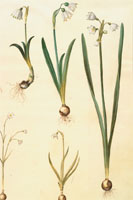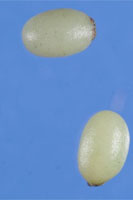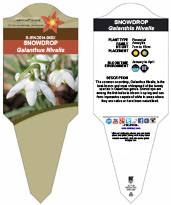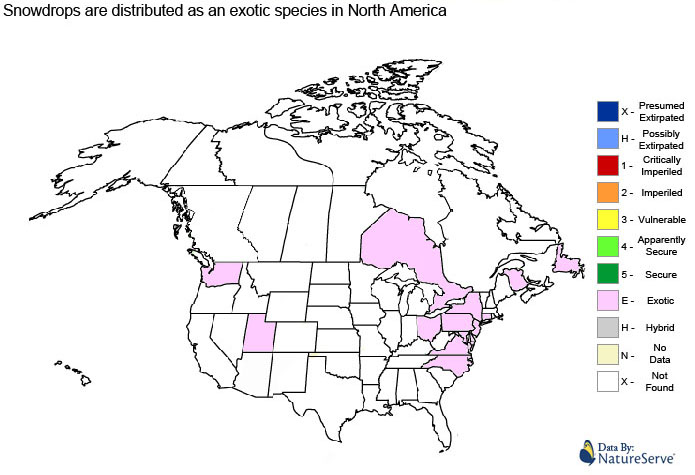
The common snowdrop, Galanthus Nivalis, is the best-known and most widespread of the twenty species in Galanthus genus. Snowdrops are among the first bulbs to bloom in spring and can form impressive carpets of white in areas where they are native or have been naturalized. They should not be confused with group of flowers called snowflakes, in the genera Leucojum and Acis. The genus name Galanthus is derived from the greek words 'gala' which means milk, and 'anthos' which translates to flower. The genus name was given by Carl Linnaeus in 1735. He described Galanthus nivalis in his Species Plantarum published in 1753. The epithet 'nivalis' means "of the snow", referring either to the snow-like flower or the plant's early flowering.
The common name snowdrop first appeared in the 1633 edition of John Gerard's "Great Herbal". However, in the first edition of "Great Herbal" he described it as the "Timely flowering Bulbus violet". The derivation of the name is uncertain, although it may have come from the German word Schneetropfen, which was a type of earring popular around that time. Other British traditional common names include "February fairmaids", "dingle-dangle", "Candlemas bells", "Mary's tapers" and, in parts of Yorkshire, "snow piercers."
Snowdrops contain an active substance called galantamine (or galanthamine) which is currently being studied in the treatment of Alzheimer's disease.
Within the realm of rational and holistic medicine, there is currently no historical, or current, uses for snowdrops.
Please note that MIROFOSS does not suggest in any way that plants should be used in place of proper medical and psychological care. This information is provided here as a reference only.
Snowdrops may have long term toxicity concerns and should not be consumed. The bulb of the snowdrop plant is considered to be poisonous.

Snowdrops are a spring perennial herbaceous plant which can grow from 7cm to 15cm tall, flowering between January and April in the northern temperate zone. Snowdrops grow from a bulb which produces two linear, or very narrowly lanceolate, grayish-green leaves and an erect, leafless scape (flowering stalk), which bears at the top a pair of bract-like spathe valves joined by a papery membrane. From the pair of spathe valves a solitary, pendulous, bell-shaped white flower emerges, held on a slender pedicel. The flower consists of six tepals, also referred to as segments with the outer three being larger and more convex than the inner ones. The inner flower segments are usually marked on their outer surface with a green or greenish-yellow V- or U-shaped mark (sometimes described as "bridge-shaped") over the small sinus (notch) at the tip of each tepal. The inner surface has a faint green mark covering all or most of it. Occasionally plants are found with green markings on the outer surface of the outer tepals. The six long, pointed anthers open by pores or short slits. The ovary is three-celled, ripening into a three-celled capsule. Each whitish seed has a small, fleshy tail (the elaiosome) containing substances attractive to ants which distribute the seeds. The leaves die back a few weeks after the flowers have faded.
| Plant Height |
7cm to 15cm |
| Habitat |
Forests, Thickets, Clearings, Lawns, Gardens |
| Leaves |
Lanceolate |
| Leaf Margin |
Entire |
| Leaf Venation |
Parallel |
| Stems |
Smooth Stems |
| Flowering Season |
January to April |
| Flower Type |
Radially Symmetrical |
| Flower Colour |
White |
| Pollination |
Bees, Insects |
| Flower Gender |
Flowers are hermaphrodite and the plants are self-fertile |
| Fruit |
Soft white seeds |
| USDA Zone |
3B (-34°C to -37°C) cold weather limit |
The following health hazards should be noted when handling or choosing a location to snowdrops:
 |
BIOHAZARD POTENTIAL
Snowdrops contain an agglutinin named Galanthus Nivalis Agglutinin (GNA) which shows damage to the intestines and immune systems of rats fed GNA.
|
 |
TOXIC
The bulb of the snowdrop plant is mildly toxic. |
 |
-Click here- or on the thumbnail image to see an artist rendering, from Pinterest, (original source unknown) of snowdrops. (This image will open in a new browser tab) |
 |
-Click here- or on the thumbnail image to see a magnified view, from the Pacific Bulb Society, created by David Pilling, of the seeds created by snowdrops for propagation. (This image will open in a new browser tab) |
Snowdrops can be referenced in certain current and historical texts under the following five names:
Snowdrops can be translated into the following select languages:
| Arabic |
زهرة اللبن الثلجية |
Bulgarian |
кокиче |
Chinese (Sim) |
雪花莲 |
| Croatian |
Visibaba |
Czech |
Sněženka |
Danish |
vintergæk |
| Dutch |
Sneeuwklokje |
Esperanto |
|
Estonian |
|
| Finnish |
Lumikello |
French |
perce-neige |
German |
Schneeglöckchen |
| Greek |
Λευκόιο |
Hebrew |
שַׁלגִית |
Hungarian |
Hóvirág |
| Italian |
Bucaneve |
Japanese |
スノードロップ |
Korean |
헌병 |
| Punjabi |
|
Lithuanian |
snieguolė |
Norwegian |
|
| Persian |
|
Polish |
Przebiśnieg |
Portuguese |
campânula-branca |
| Romanian |
ghiocel |
Russian |
Подснежник |
Slovak |
snežienka |
| Spanish |
Campanilla de febrero |
Swedish |
Snödroppe |
Tagalog |
|
| Turkish |
Kardelen |
Ukrainian |
Пролісок |
Vietnamese |
cây tuyết điểm hoa |
| The information provided in this conservation assessment has been provided by the Natureserve Database in conjunction with various federal, provincial, state, county, district, regional, and municipal governments as well as public and private conservation authorities. Information in this section is accurate from the last time this article was updated. |
 |
Snowdrop has no conservation status as it is considered an exotic and or invasive species in North America. |
 |
The MIROFOSS database offers free printable garden tags for personal and non-profit use. These tags can be used to properly identify plant samples in a garden. Click on the tags shown on the the screen or -click here- to download a full size jpeg image for a snowdrop identification tag; which can be printed on paper or used with a plastic laser printer. |
 |
What's this?
This is a QR code (short for Quick Response) which gives fast-track access to MIROFOSS articles. QR Codes are barcodes that can be read by smart phone cameras. This QR Code is unique to this MIROFOSS article.
What can I do with it?
You can copy and print the QR code to a plant label, poster, book, web site, magazines, or newspaper so smart phone users can scan the QR Code which automatically takes them to this specific article.
|

| Description |
Davis, Aaron P.; Royal Botanic Gardens, Kew (1999). The genus Galanthus. A Botanical magazine monograph. Timber Press. ISBN 978-0-88192-431-2. |
| Folklore |
Plaitakis, A., Duvoisin, R. C. (March 1983). "Homer's moly identified as Galanthus nivalis L.: physiologic antidote to stramonium poisoning". Clinical Neuropharmacology 6 (1): 1–5. doi:10.1097/00002826-198303000-00001. PMID 6342763 |
| Commerical Use |
Gvaladze, G. E. (1983). "Ultrastructural study of Embryo Sac of Galanthus nivalis L.". In Erdelská, O. Fertilization and embryogenesis in ovulated plants. VII. International Cytoembryological Symposium, High Tatra (Račkova dolina), June 14–17, 1982. Bratislava: Centre of Biological and Ecological Sciences, Institute of Experimental Biology and Ecology, Slovak Academy of Sciences. OCLC 15866997 |
| Image Rendering |
USDA-NRCS PLANTS Database / USDA NRCS. Wetland flora: Field office illustrated guide to plant species. USDA Natural Resources Conservation Service. |
| Environment |
National Audubon Society. Field Guide To Wildflowers (Eastern Region): Alfred A. Knopf. ISBN 0-375-40232-2 |
| Physical Identification |
National Audubon Society. Field Guide To Wildflowers (Eastern Region): Alfred A. Knopf. ISBN 0-375-40232-2 |
| January 20, 2016 |
The last time this page was updated |
| ©2021 MIROFOSS™ Foundation |
 |
|
|





















